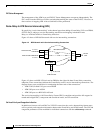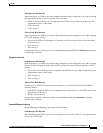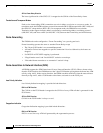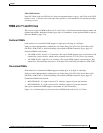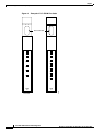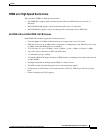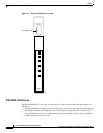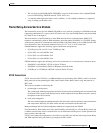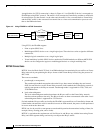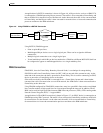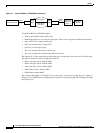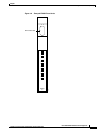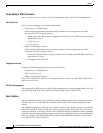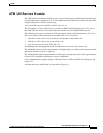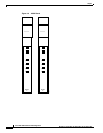
4-11
Cisco MGX 8220 Installation and Configuration
Release 5.0, Part Number 78-6430-03 Rev. D0, November 2003
Chapter
Frame Relay Service Modules (FRSMs)
• The very high-speed FRSM (MGX-FRSM-HS2) supports all the features of the standard FRSM
(service interworking, FR/ATM network, FUNI, and so on).
• As with the other high-speed frame service modules, 1:1 hot-standby redundancy is supported
using Y-cabling on the back cards.
Frame Relay Access Service Module
The Frame Relay Access Service Module (FRASM) is a two-card set consisting of a FRASM front card
(supporting channelized,T1, 8 port), and an 8T1 back card. Up to ten FRASM modules may be installed
in a shelf in slots 5 through 14.
The main function of the FRASM is to allow IBM network devices and mainframes (IBM 3270
terminals communicating with an IBM mainframe) operating under SNA/SDLC or 3270/BSC (binary
synchronous) protocols to communicate with each other using Frame Relay over an ATM network. This
is an alternative to the conventional method of using T1, E1, V.35, or X.21 leased lines.
FRASM modules support the following logical connections and protocols:
• PU4 (Physical Unit 4) to PU2 over 3270/Bisync link
• PU4 to PU2 over a SNA/SDLC link
• PU2 to PU2 over a SNA/SDLC link
• PU4 to PU4 over a SNA/SDLC link
FRASM modules support the following end-to-end connections on a connection-by-connection basis:
• SNA/SDLC to SNA/SDLC (STUN for Serial TUNnel)
• SNA/SDLC to Frame Relay (BNN for Boundary Network Node)
• 3270/Bisync to 3270/Bisync (BSTUN for Block Serial TUNnel)
STUN Connections
STUN, short for Serial TUNnel, is an IBM technique for transmitting SNA (SDLC) traffic over Frame
Relay networks by encapsulating the SNA frames within Frame Relay frames using the protocol of
RFC 1490.
There are two methods of achieving this
1. passthrough (or transparent)
The passthrough method encapsulates the entire SNA data stream including data and control fields
for transmission over the Frame Relay network. In this method, the Frame Relay network is entirely
transparent to the SNA network.
2. local acknowledgment
The local acknowledgment method terminates the SNA traffic at the Frame Relay network interface
and encapsulates data only, the SNA frames are then reconstructed at the other end.
Both passthrough and local acknowledgment methods are supported by the FRAM.
For both methods, SNA traffic received by the FRASM is converted first to a Frame Relay format and
is further converted into cells for transmission over an ATM network The process is then performed in
reverse order at the other end.
STUN is used where the requirements call for SNA in and SNA out with the intervening Frame Relay
and ATM segments being used merely to transport the SNA traffic.




